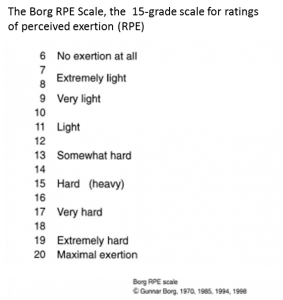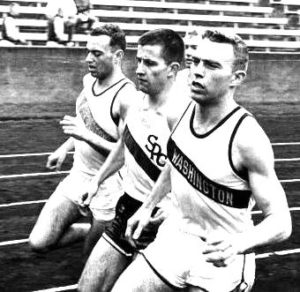Measuring exercise intensity using self-talk or a rating scale helps in achieving an appropriate exercise activity. These aids can help in exercise therapy, wellness promotion, and lifestyle maintenance. Also they can minimize post-exertional malaise. This post discusses how we can use self-talk or The Talk Test and also rating scales to evaluate and produce our own exercise intensity.
Use Self-Talk for Measuring Exercise Intensity
Phil Weiser (P): In the last post, Leg Fatigue: Hilly Hikes Really Tires Me, I had to measure exercise intensity using self-talk to avoid relapses of post-exertional malaise.
Karl Weiser (K): How did you use self-talk to do that?
P: I’m guessing that when you and I were kids, we did a lot of self-talking.
- At first, we were constantly talking out loud as we played.
- Then we talked out loud less, especially when grown-ups were around.
- Eventually our talking was internalized.
- And I know I still talk to myself.
K: Please give some examples!
Examples of Self-Talk
P: Here’s one example:
- “Am I walking too fast right now?
- “Yes. I am.
- “I’d better slow down and save some energy for tomorrow.”
K: Oh. I get it.
P: In the picture above, each walker may be utilizing another form of self-talk:
- “Hmm. Am I talking in sentences as we walk?”
- “Yes. Attaway! The pace is OK.”
- Or “No. in phrases. I had better slow down.”
- Or “No, in paragraphs. I had better request that we walk faster.”
K: Actually, this is “The Talk Test” that notices if one’s self-talk or even conversational talk is in sentences (OK), phrases (too fast), or paragraphs (too slow).
P: Here is a partial list of other web sites that discuss using self-talk or The Talk Test for measuring exercise intensity:
- Centers for Disease Control and Prevention
- American College of Cardiology
- Greatist.com
- HealthAndStyle.com
K: Now tell me about using rating scales.
Measuring Exercise Intensity using Rating Scales
P: The disadvantage of self-talk is one of communication; it’s not external talk, it is only internal talk. An advantage of rating scales is that they are a means of sharing with others what we are feeling inside:
- A rating scale is a list of adjectives; for example,
nothing at all
weak
moderate
strong
very strong - And it has numbers to choose from, or squares to check.
K: How do you choose the rating number for the rating?
P: In fact, we use specific types of self-talk to measure exercise intensity.
- If we know about being aware of our symptoms, our discomforts,
- then we can start to read the adjectives and say the number for its intensity.
- In psychological terms, we are using magnitude estimation.
- After becoming proficient at monitoring the exercise intensity,
- we can start setting the workrate by, say, making the workrate more or less.
- Again, in psychological terms, we are using magnitude production!
K: Please give me an example!
An Example of a Rating Scale
P: The Borg Rating of Perceived Exertion (RPE) Scale is one of the better known rating scales utilized for measuring exercise intensity:

P: This is the Exertion (Effort) Scale developed by Gunnar Borg in the 1950s.
- Note that a score of “6” is associated with a heart rate (HR) about 60 beats per minute (bpm) when doing “no exertion at all.”
- And “20” is associated with a HR about 200 or “maximal.”
K: How do you choose the rating number?
Instructions
P: Instructions are the key. For example, for the Borg RPE scale shown above, the exercise therapist would say these instructions:
“While exercising we want you to rate your perception of exertion, i.e., how heavy and strenuous the exercise feels to you.
“The perception of exertion depends mainly on the strain and fatigue in your muscles and on your feeling of breathlessness or aches in the chest.
“Look at this rating scale; we want you to use this scale from 6 to 20, where 6 means “no exertion at all” and 20 means “maximal exertion.”
“Try to appraise your feeling of exertion as honestly as possible, without thinking about the actual physical load.
“Look at the scale and the expressions and then give a number.” (modified from Borg, 1998, page 47)
K: How do you produce the correct running pace for the rating?
P: Well, for example, I remember one day at the University of Washington, the distance runners were to run 10 440s averaging 64 seconds.
- After the fifth quarter, the coach yelled, “Now, Phil. Lead the next one in 62 seconds!”
- And off I went leading the pack, and its time was 61.5 seconds.
- I have often wondered how I did that!
- Maybe we have a feed forward neuromuscular mechanism to help set and adjust our pace.
K: Me, too. I was in that pack! Our bodies sometimes seem very mysterious. Incidentally, can a patient use this set of instructions to produce an appropriate exercise intensity?
Conclusion about Measuring Exercise Intensity and Next Steps
P: Yes, it works for learning and using as a means oi measuring exercise exertion for self-regulation.
- In the ’90s my colleagues and I helped some patients with cardiovascular disease.
- At the start of a 6 minute cycling segment of the rehabilitation session, the patient set the initial cycling exercise intensity to achieve Target Heart Rate (THR) at 6 min.
- At 2 and/or 4 minutes they could adjust the mechanical resistance of the cycle ergometer to achieve THR at 6 min.
- It worked! At 2 and/or 4 min cardiac patients did adjust exercise intensity to achieve THR at 6 min.
- In fact, patients who did overshoot THR at 2 min, then reduced the workrate at 2 and/or 4 min to obtain THR at 6 min.
K: I’d like to learn more about how you all did this. Please, make this you topic for next post!
Reference
Borg, G. (1998) Borg’s Perceived Exertion and Pain Scales. Champaign, IL: Human Kinetics.

